Product Images Desvenlafaxine
View Photos of Packaging, Labels & Appearance
Product Label Images
The following 9 images provide visual information about the product associated with Desvenlafaxine NDC 51991-006 by Breckenridge Pharmaceutical, Inc, such as packaging, labeling, and the appearance of the drug itself. This resource could be helpful for medical professionals, pharmacists, and patients seeking to verify medication information and ensure they have the correct product.
desvenlafaxine 100

This is a medication named Desvenlafaxine, which is available in extended-release tablet form. Each package contains 30 tablets, which are dispensed as a unit. The medication guide should be provided to each patient along with the medication. The usual dosage is not mentioned, but it should be checked on the package insert. The medication needs to be stored at a temperature between 20°C and 25°C (68°F to 77°F) and can be permitted to be stored between 15°C and 30°C (59°F to 86°F). The manufacturer of the medication is Alembic Pharmaceuticals Limited, and the distribution is done by Breckenridge Pharmaceutical, Inc. However, it is unclear what the text initially describes.*
desvenlafaxine 50

Desvenlafaxine is a medication available in the form of extended-release tablets with 50mg equivalent to 76mg desvenl. It is suggested to refer to the package insert for usual dosage information. The tablets should be stored within the temperature range of 20°C to 25°C (68°F to 77°F), with permitted excursions from 15°C to 30°C (59°F to 86°F) and are distributed by a pharmaceutical company, Dee Pharmaceutical, Inc. The manufacturer of the tablets is Alembic Pharmaceuticals Ltd (Formulation Division), located in India. The tablets come in a package size of 30 and have an NDC code of 51991-311-33. The accompanying medication guide should be dispensed to each patient by the pharmacist.*
Figure 1 - desvenlafaxine figure1
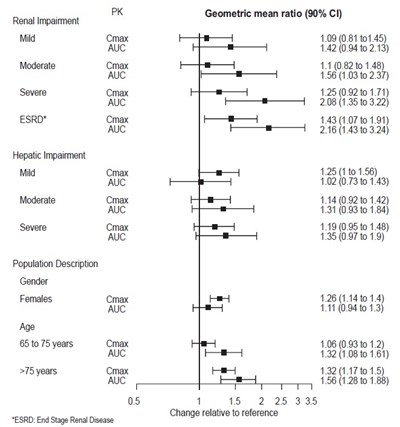
This text provides information on the impact of renal and hepatic impairment, as well as population description data on gender and age. The results are displayed in terms of geometric mean ratio and change relative to a reference. The data indicates that mild, moderate, and severe renal impairment have varying impacts on drug concentration (Cmax) and area under the curve (AUC), whereas hepatic impairment has a consistent impact on Cmax and AUC. The text also provides information on the impact of age and gender on drug concentration and AUC.*
Figure 2 - desvenlafaxine figure2
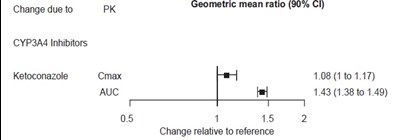
This text appears to be a pharmacokinetic (PK) analysis of the effect of CYP3A4 inhibitors on the drug ketoconazole. The table shows the geometric mean ratios of the maximum concentration (Cmax) and area under the curve (AUC) of ketoconazole in the presence of the inhibitors compared to a reference. The numbers represent the percent change in Cmax and AUC. However, it is unclear what the units are and the context of the analysis.*
Figure 4 - desvenlafaxine image4
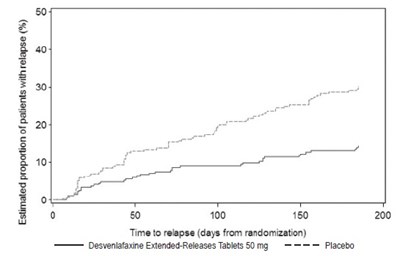
This appears to be a graph showing the estimated proportion of patients with relapse over time for Desvenlafaxine Extended-Release tablets 50mg and placebo. The X-axis shows the time to relapse in days, and the Y-axis shows the estimated proportion of patients with relapse in percentage (%). The graph indicates a higher proportion of patients with relapse with placebo compared to Desvenlafaxine after approximately 50 days from randomization.*
Figure 5 - desvenlafaxine image5
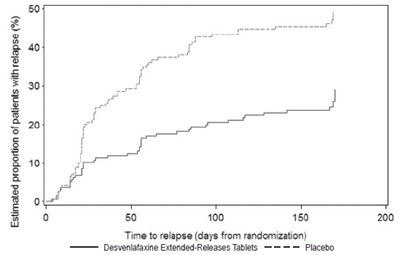
This appears to be a graph displaying the estimated proportion of patients experiencing a relapse over time while taking Desvenlafaxine Extended-Release Tablets versus a placebo. The graph shows the percentage of relapse in increments of 10% from 20% to 50% on the y-axis, while the x-axis displays the time to relapse in days from randomization with intervals marked at 50 day increments. It appears that the Desvenlafaxine Extended-Release Tablets have a lower rate of relapse compared to the placebo.*
Structure - desvenlafaxine structure1
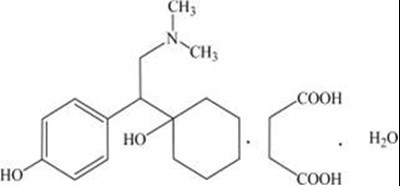
The text seems to be chemical formulas. "HO'", "HO'", and "COOH" represent hydroxyl group and carboxyl group respectively, which are often found in organic compounds.*
* The product label images have been analyzed using a combination of traditional computing and machine learning techniques. It should be noted that the descriptions provided may not be entirely accurate as they are experimental in nature. Use the information in this page at your own discretion and risk.

